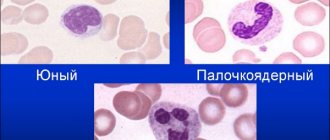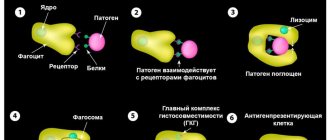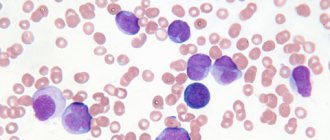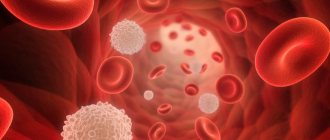Neutrophils are one of the components of the leukocyte formula, a decrease in the level of which characterizes inflammatory processes, blood diseases, and in some cases indicates the occurrence of other pathologies in the body. In medical practice, a reduced level of neutrophils is called neutropenia, but what is the reason for this phenomenon - let's figure it out.
What are neutrophils and how are they formed?
Neutrophils (neutrophil lymphocytes) are granulocytic blood cells (the name is due to the presence of granules in the cytoplasm), which are part of the leukocyte formula and are responsible for suppressing foci of infection.
The content of neutrophils in the blood ranges from 45 to 70% of the total number of leukocytes.
There are two forms of neutrophils in human blood: band-nuclear and segmented; the fundamental distinguishing feature of both forms lies in the “age” of the cells. Band neutrophils are young cells formed by red bone marrow; their nucleus is one solid rod.
Subsequently, the cell enters the blood plasma, where it matures to a segmented form, that is, the rod is divided into segments. Neutrophil lymphocytes remain in the peripheral blood for only 2-3 hours, and then migrate to tissue structures. Moreover, the lifespan of such cells directly depends on the presence of pathological processes in the body and ranges from 2-3 hours to 2-4 days.
Leukocytes are also called white blood cells or white blood. They are responsible for the human immune system, a barrier established by the body against diseases, toxins, various viruses and harmful bacteria. Read more in the article: “why leukocytes in the blood are elevated, causes and symptoms.”
Normal neutrophil count
In an adult and a child, the indicators may vary: the former are characterized by a content of 50-70% of the total number of leukocytes; in newborns, as a rule, this figure does not exceed 30% and by the age of 16-17 it levels off with the norm for adults.
Very often, band neutrophils can be elevated in the event of a virus attack on the human body. The reasons for this are the continuous reproduction of cells such as monocytes (mononuclear leukocytes) by the bone marrow. Their main function is to resist infection. If the immune system malfunctions, the reverse process occurs. This is reflected in the indicators obtained during the analysis (leukocytes will be lowered).
Neutrophil function and indications for their determination
The leukocyte formula gives a general idea of human immunity and includes a harmonious ratio of five leukocytes: monocytes, eosinophils, lymphocytes, neutrophils and basophils. Violation of the norm of these indicators in a general blood test helps to recognize pathologies, including malignant neoplasms.
Indications for a general blood test, in particular to determine the quantitative ratio of the neutrophil fraction, are the following diseases:
- upper respiratory tract diseases (sore throat and pneumonia);
- pathologies of parenchymal organs (pancreatitis and cholecystitis);
- sepsis, gangrene and extensive burns of the skin;
- heart attack;
- tuberculosis;
- hypoplastic and aplastic anemia;
- blood loss;
- appendicitis and peritonitis;
- chemical poisoning;
- rheumatic attacks.
In general, leukocytes perform a protective function for the body: they create a barrier to pathogenic microflora (infections, viruses and bacteria), and are also designed to absorb pathogenic bacteria, the products of their vital activity and decay.
When a virus enters the human body or an inflammatory process begins, the body temperature rises, thus the immune system fights the pathogen. Read more in the article: “lowering body temperature at home.”
The leukocyte protective barrier involves the complex functioning of individual factions, each of which strictly performs its own functions. Thus, the task of neutrophils is to absorb pathogenic microorganisms and break them down in their own body. Having completed its “mission,” the neutrophil lymphocyte dies, forming exudate and attracting other leukocyte cells. At the same time, the neutrophil secretes antibacterial substances and enzymes.
The mechanism is simple: if there is a focus of inflammation in the body, a segmented (adult) neutrophil from the blood is directed to the pathogenic focus, so its quantitative ratio with other leukocytes in the blood stream may temporarily decrease. A sharp decrease in cell levels in some cases occurs due to intensive therapeutic methods such as radiation or chemical therapy.
Blood test and its interpretation
Advertising:
A general blood test allows you to determine the percentage of the neutrophil fraction with other cells. Blood sampling is carried out in a standard way: from a vein or finger in the morning on an empty stomach.
Neutrophils react more to a bacterial infection, and lymphocytes - to a viral one.
Based on the functional characteristics of leukocytes and their ratio, the nature of the disease is judged:
- during an acute viral infection, segmented neutrophils are reduced, and leukocytes and lymphocytes are increased;
- with chronic ARVI, segmented cells and leukocytes are reduced, and lymphocytes are increased;
- with bacterial damage to the body, the ratio changes in the opposite direction: leukocytes and neutrophils increase, and lymphocytes, on the contrary, will decrease.
At the same time, the total level of monocytes, eosinophils and basophils during ARVI increases slightly and is rarely diagnosed, mainly during pregnancy. To identify such inflammatory processes, ESR - erythrocyte sedimentation rate - is taken into account.
Bacterial damage has a more complex biological form, in contrast to the viral nature of the disease. Therefore, by identifying the amount of the neutrophil fraction, dangerous diseases caused by: Escherichia coli, Koch and Leffler bacilli, clostridia, and treponema pallidum are reliably determined.
Low neutrophil levels are a cause for concern
In an adult, neutrophils may be reduced if any dangerous disease occurs. To find out the causes of the disease, it is necessary to undergo a procedure in which blood is taken for analysis for subsequent study. Of particular interest to the laboratory assistant are:
- lymphocytes;
- monocytes;
- neutrophil level.
If the analysis shows that segmented neutrophils are reduced, then this information may indicate that the body is infected with an infection and its active spread. This condition is called neutropenia.
With a critical decrease in the level of segmented neutrophils, suspicions arise and an objective need arises for further examination for diseases such as:
- thrombocytopenia;
- leukemia;
- deficiency of vitamins such as B12;
- anemia;
- metastases in the bone marrow;
- stomach ulcer;
- duodenal ulcer;
- anaphylactic shock;
- viral infection:
- poisoning;
- complications after courses of radiation therapy.
A decrease in segmented neutrophils also occurs in cases where the patient lives in poor environmental conditions. It has been noted that long-term use of drugs such as:
- Penicillin;
- Analgin.
In women during pregnancy and lactation, neutrophils may be increased. This is due to the fact that the fetus in the uterus produces waste products. This process provokes the release of additional leukocytes into the blood, including neutrophils. It is necessary to constantly monitor their indicators and avoid sudden deviations from the norm, especially downward, since if neutrophils are significantly reduced, this may signal a threat such as the risk of miscarriage.
Decoding the norms for neutrophil lymphocyte indicators
The state of the human immune system when deciphering the analysis is determined by the percentage of young and mature cells. The normal indicators do not depend on gender; for women and men the percentage of neutrophils will be the same. But at the same time, the patient’s age is taken into account.
Band cells are always elevated in infants and make up from 3 to 12% of the total number of leukocytes, but by the month of life the balance between young and mature cells returns to normal.
In children under 3 years of age, immunity has not yet been formed, so the percentage of segmented cells may fluctuate, which is also considered normal within acceptable values.
Advertising:
The following are the norms for neutrophil levels in a child, adolescent and adult.
| Person's age | Band cells | Segmented cells |
| Newborn | 3-12% | 46-70% |
| Infant up to 2 weeks of life | 1-5% | 30-50% |
| Infant from 2 weeks to a year of life | 1-5% | 16-46% |
| 1-2 years | 1-5% | 28-48% |
| 3-5 years | 1-4% | 32-55% |
| 6-7 years | 1-4% | 37-58% |
| 8-9 years | 1-4% | 41-60% |
| 10-11 years | 1-4% | 43-60% |
| 12-15 years | 1-4% | 45-60% |
| from 16 years old and adults | 1-3% | 45-70% |
Before conducting a general analysis, you need to warn your doctor or stop taking certain medications that distort the level of neutrophil granulocytes. These include: sulfa drugs, diuretics, corticosteroids, penicillin drugs and analgesics.
Indicator 0
There is an indicator of 0 – what does this mean? Indicator 0 in a child and 0 in an adult can most often be provoked by the following factors:
- Bacterial infections such as typhus, tularemia or chronic brucellosis.
- Viral infections that can lead to a decrease in neutrophils. In such a situation, the patient may become ill with rubella, influenza, scarlet fever, measles, diphtheria or viral hepatitis.
- Toxic effects of medications.
- Anemia can cause a lack of neutrophils in an adult or child.
- Because of radiation.
Causes of low blood cell levels
The etiology of a possible decrease in neutrophil granulocytes is divided into three types:
- Congenital;
- Acquired;
- Idiopathic (for unknown cause).
Advertising:
Congenital neutropenia is dangerous primarily for the child, since the unformed weakened immune system “misses” pathogenic microorganisms. For this reason, young children can often get sick with subsequent complications. As you grow older, the pathology softens due to the body's adaptation: missing leukocytes are replaced by other fractions of the leukocyte formula.
For people of any age, the phenomenon of neutropenia against the background of ongoing agranulocytosis is dangerous - the death of immature neutrophils, which requires long-term and complex therapy.
Also in medical practice, a reduced level of the neutrophil fraction, taking into account the severity of the pathology, is divided into mild, moderate and severe neutropenia. The degree of reduction in this case is due to ongoing pathological processes in the body due to which neutrophils are quickly destroyed or produced in insufficient quantities. Determining the primary source is the task of the hematologist.
The causes of acquired neutropenia differ in adults and children. Let's look at them.
Decreased granulocytes in children
If the reasons for the low level of segmented cells are not due to a lack of bone marrow function or other congenital anomalies, the primary source is sought among the following diseases:
- infections such as influenza, measles, rubella, hepatitis;
- fungal diseases;
- anemia;
- vaccination;
- chemical poisoning;
- purulent inflammation;
- anaphylactic shock.
In this case, the prescription and duration of previous illnesses are taken into account. It is possible that if the child recently had a cold, the level of neutrophils simply did not have time to recover. Therefore, there is no need to panic; for an objective assessment of the state of the immune system in children, it is recommended to retake a general blood test after 2-3 weeks.
Decreased granulocytes in adults
Advertising:
In adults, deviation from the norm often occurs against the background of an ongoing disease, but in some cases it can manifest itself as a consequence of therapy already performed:
- tuberculosis;
- bacterial infections: pneumonia, otitis media, sepsis;
- radiation therapy;
- endocrine and chronic diseases: diabetes mellitus, hypothyroidism, gastric ulcer and others.
A decrease in neutrophils is often observed in athletes, so if a person was exposed to severe physical activity and then took the test, the percentage of segmented cells may also be reduced.
As you can see, the reasons for the decrease in the neutrophil fraction can be various factors: from minor fluctuations in immunity to serious diseases of the body. Therefore, if a low level of neutrophils is detected in a blood test, there is no need to panic. The optimal solution is a consultation with a doctor and further comprehensive examination to identify and eliminate the original source of the problem.
Neutrophils are below normal - what does this mean?
The analysis can reveal reduced neutrophils in a person if a viral infection has entered the body, an inflammatory disease is occurring, or radiation exposure has been carried out, which caused anemia. A decrease in neutrophils in the blood will be detected if a person lives in poor environmental conditions and uses certain groups of medications, for example, sulfonamide, chloramphenicol, penicillin, analgin. This phenomenon is called neutropenia. Depending on the nature of the processes, several variants of this pathology are distinguished. Types of neutropenia:
- congenital;
- acquired;
- idiopathic (unexplained).
There are also true and relative neutropenia. In the first case, the number of cells in the blood is reduced, and in the second, they are reduced in relation to other species. Doctors use several categories that indicate the severity of the disease:
- mild neutropenia;
- moderate neutropenia;
- severe neutropenia;
A decrease in the number of immune cells occurs due to their too rapid destruction, long-term inflammatory diseases, and functional/organic failures of hematopoiesis in the bone marrow. If these cells are low, the issue of treatment is dealt with by a hematologist. He will determine the root cause of this condition and prescribe therapy that will eliminate it.
Reduced neutrophils in the blood of a child
This is one of the most important indicators of clinical analysis. Low neutrophils in the blood are detected if the child has recently suffered a bacterial or viral disease, has taken a course of medications, or has had food poisoning. If neutrophils in a child’s blood are low for no apparent reason, the doctor may suspect bone marrow pathology. A decrease occurs due to its insufficient functioning or resistance to serious diseases. Leukocytes may be low for reasons such as:
- chemical poisoning;
- hereditary disease;
- irradiation;
- one of the forms of anemia;
- liver pathology (hepatitis);
- measles;
- rubella.
Neutrophils are low in an adult - reasons
The reason that in adults the number of protective cells in the body is reduced, as in children, is often the ongoing severe inflammatory processes. As a rule, a noticeable change occurs only in severe forms of pathology, the fight against which takes a large number of leukocytes. If neutrophils are low in an adult, the reasons may be the following:
- taking medications that suppress the immune system;
- radiation exposure;
- polluted environment;
- infections;
- poisoning of the body.
In some people, a condition is detected when the protective cells are first lowered, then increased and then decreased again. This phenomenon is called cyclic neutropenia. With this disease, every few weeks/months an Abs analysis suddenly shows that there are no neutrophils. In this case, an increased level of eosinophils and monocytes is observed.
- Neutrophils are reduced in an adult. Causes of lymphocytes increased, decreased in the analysis
Low neutrophils and high lymphocytes
The analysis may reveal that neutrophils in the blood are low and lymphocytes are high. This condition indicates that the patient has suffered from influenza or an acute viral infection. The number of protective cells should return to previous levels relatively quickly. If this does not happen, then the following pathologies may be the cause of high lymphocytes:
- tuberculosis;
- lymphosarcoma;
- lymphocytic leukemia;
- HIV.
Decrease in segmented neutrophils in the blood
This condition indicates problems with hematopoiesis in the bone marrow and a weakened immune defense. A decrease in segmented neutrophils in the blood occurs in the presence of an acute viral infection or exposure to one of the factors described below:
- the presence of antibodies to leukocytes;
- immune complexes that circulate through the blood;
- toxic poisoning of the body.
Band neutrophils are reduced
Neutropenia can be suspected if a person is often exposed to infectious diseases. Band neutrophils will be reduced if a person is often diagnosed with stomatitis, damage to the outer, middle ear, oral cavity, and gums. This group of cells are not fully mature neutrophils. Their number directly affects a person’s overall immunity. The following reasons for the decrease in band cells are identified:
- anemia;
- drug addict;
- poor environmental conditions;
- radiation exposure;
- viral infection;
- neutrophilia;
- some medications;
- inflammatory processes;
- erythremia;
- exogenous intoxication with lead, poisons;
- chronic myeloid leukemia;
- endogenous intoxications;
- purulent-necrotic sore throat
- ginginitis;
- allergy;
- soft tissue necrosis.
Neutrophils are decreased, monocytes are increased
Any pathology to which the human body is exposed causes an increase in the number of monocytes. This phenomenon is called monocytosis. As a rule, it leads to a decrease in leukocytes, which is characteristic of lymphocytopenia and neutropenia. Neutrophils will be reduced and monocytes will be increased in the presence of the following diseases:
- chronic myelomonocytic or monocytic leukemia;
- arthritis, lupus erythematosus, ploiarteritis;
- protosis/rickettsial viral infection, infective endocarditis;
- acute monoblastic leukemia, lymphogranulomatosis;
- ulcerative colitis, brucellosis, syphilis, enteritis.









